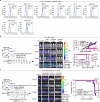Dual targeting of tumoral cells and immune microenvironment by blocking the IL-33/IL1RL1 pathway
- PMID: 40659660
- PMCID: PMC12259856
- DOI: 10.1038/s41467-025-61567-7
Dual targeting of tumoral cells and immune microenvironment by blocking the IL-33/IL1RL1 pathway
Abstract
Leukemia stem cells (LSCs) are a small yet powerful subset of leukemic cells that possess the ability to self-renew and have a long-term tumorigenic capacity, playing a crucial role in both leukemia development and therapy resistance. These LSCs are influenced by external and internal factors within the bone marrow niche. By delving into the intricate interplay between LSCs and their immune environment, we can pave the way for innovative immunotherapies that target both the malignant stem cells and the suppressive immune microenvironment, addressing both the "seed" and the "soil" simultaneously. Through the analysis of public datasets and patient samples, we show that elevated IL1RL1 expression correlates with poor prognosis and therapy resistance in acute myeloid leukemia (AML). At the core of this process, stem cell leukemogenesis initiation and maintenance signals are driven by a stress-induced IL-33/IL1RL1 autocrine loop. This LSC-induced IL-33/IL1RL1 signaling fosters an immune regulatory microenvironment. Therefore, IL1RL1 emerges as a promising therapeutic target, with IL1RL1-specific T cell-engaging bispecific antibodies holding great potential as cutting-edge immunotherapeutics for AML.
© 2025. The Author(s).
Conflict of interest statement
Competing interests: N.-K.V.C. reports receiving commercial research grants from Y-mabs Therapeutics and Abpro-Labs Inc.; holding ownership interest/equity in Y-Mabs Therapeutics Inc., holding ownership interest/equity in Abpro-Labs, and owning stock options in Eureka Therapeutics. N.-K.V.C. is the inventor and owner of issued patents licensed by Memorial Sloan Kettering Cancer Center (MSKCC) to Ymabs Therapeutics, Biotec Pharmacon, and Abpro-labs. Both MSKCC and N.-K.V.C. have financial interest in Y-mabs. N.-K.V.C. is an advisory board member for Abpro-Labs and Eureka Therapeutics. Otherwise, the authors declare that they have no competing interests.
Figures







Similar articles
-
Bone marrow microenvironment-responsive polymeric-drug/siRNA regulates leukemia stem cells assisting for prevention of AML relapse.Biomaterials. 2026 Jan;324:123516. doi: 10.1016/j.biomaterials.2025.123516. Epub 2025 Jun 18. Biomaterials. 2026. PMID: 40543323
-
ST2/IL-33 axis blockade inhibits regulatory T cell cytotoxicity towards CD8 T cells in the leukemic niche.Nat Commun. 2025 Jul 21;16(1):6580. doi: 10.1038/s41467-025-61647-8. Nat Commun. 2025. PMID: 40691440 Free PMC article.
-
Sensitizing leukemia stem cells to NF-κB inhibitor treatment in vivo by inactivation of both TNF and IL-1 signaling.Oncotarget. 2017 Jan 31;8(5):8420-8435. doi: 10.18632/oncotarget.14220. Oncotarget. 2017. PMID: 28039479 Free PMC article.
-
Mesenchymal stem cells in the bone marrow microenvironment: a double-edged sword for AML.J Cancer Res Clin Oncol. 2025 Jun 21;151(6):193. doi: 10.1007/s00432-025-06244-4. J Cancer Res Clin Oncol. 2025. PMID: 40542231 Free PMC article. Review.
-
An update on cancer stem cell survival pathways involved in chemoresistance in triple-negative breast cancer.Future Oncol. 2025 Mar;21(6):715-735. doi: 10.1080/14796694.2025.2461443. Epub 2025 Feb 12. Future Oncol. 2025. PMID: 39936282 Review.
References
-
- Levescot, A. et al. BCR-ABL-induced deregulation of the IL-33/ST2 pathway in CD34+ progenitors from chronic myeloid leukemia patients. Cancer Res.74, 2669–2676 (2014). - PubMed
MeSH terms
Substances
Grants and funding
LinkOut - more resources
Full Text Sources
Medical

